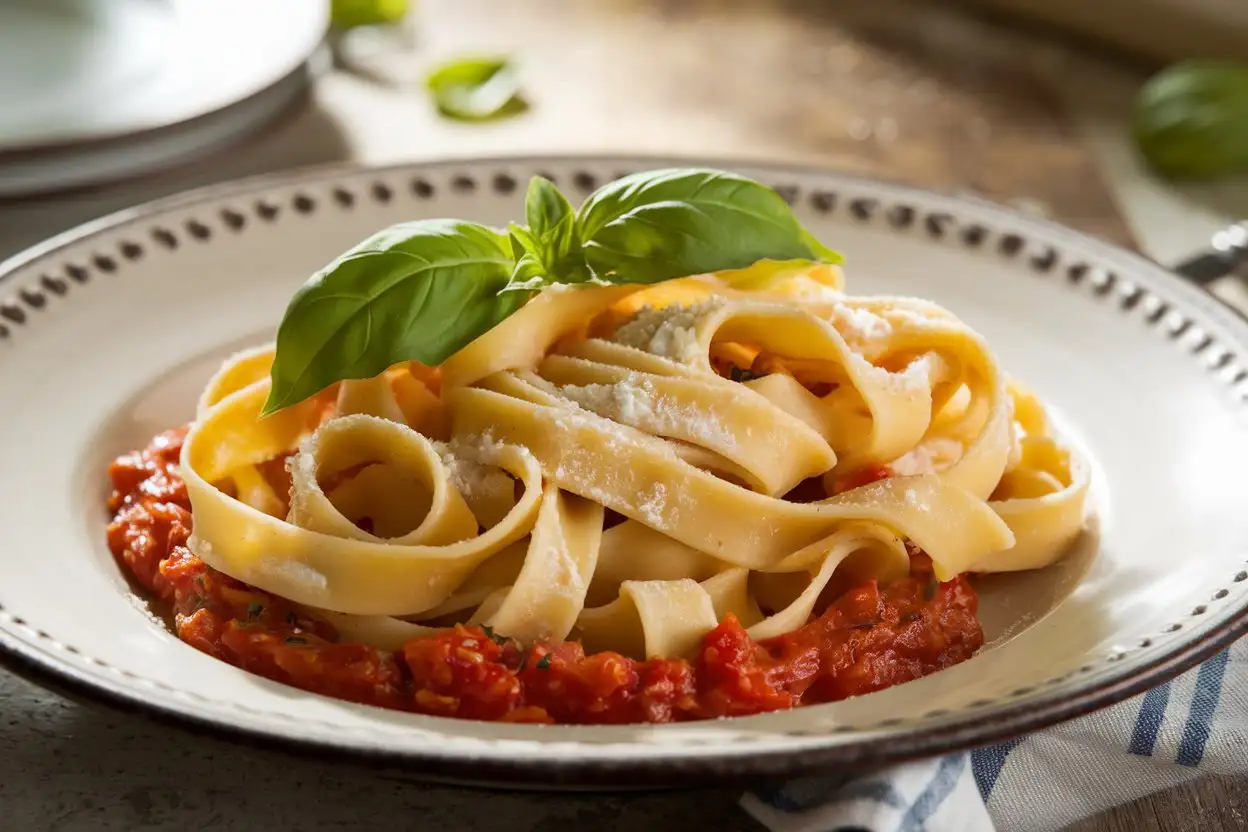Sourdough pasta is an innovative and delightful twist on the traditional homemade pasta recipe. Whether you’re a seasoned pasta maker or a curious beginner, incorporating sourdough starter into your dough introduces an exciting complexity of flavor and texture. The natural fermentation process not only improves digestibility but also adds a layer of depth to the pasta that you won’t find in regular dough. In this guide, I will walk you through the entire process, from gathering ingredients to cooking the perfect sourdough pasta.
Table of Contents
Ingredients Needed for Homemade Sourdough Pasta
Creating the best sourdough pasta requires a few simple yet essential ingredients. These components are the foundation of a successful recipe, and each contributes to the final product’s texture, flavor, and overall experience. Let’s break them down.
Flour (Tipo 00 vs. All-Purpose)
The flour you choose plays a significant role in the texture of your sourdough pasta. For the smoothest, most delicate results, I recommend using Italian Tipo 00 flour, which is finely milled and perfect for fresh pasta. This flour gives the pasta a soft, pillowy texture that holds together well without becoming too chewy. If you don’t have access to Tipo 00, all-purpose flour can serve as an excellent substitute, but keep in mind that the texture might not be as light. I suggest experimenting with both to find which suits your preference best.
Eggs for Pasta Dough
Eggs are the backbone of any pasta dough, contributing to its color, flavor, and structure. I weigh the eggs to ensure accuracy because even slight variations in egg size can affect the dough’s consistency. For optimal results, you need about 165 grams of eggs, which typically equals three large eggs. The egg’s proteins create the desired structure in the dough, making it easier to roll out into sheets and ensuring the pasta cooks to a perfect al dente texture.
Sourdough Starter or Discard
The key ingredient that sets sourdough pasta apart is, of course, a sourdough starter. It brings a subtle tangy flavor and a rich complexity to the dough. I always use a bubbly, active sourdough starter for the best results. The starter’s natural fermentation process helps break down gluten, making the pasta easier to digest. If you don’t have an active starter, sourdough discard can be used as well, but ensure it’s not too old to avoid overpowering sourness in the pasta. For an even milder flavor, opt for a well-fed, freshly collapsed discard.
Optional Olive Oil
While olive oil is not a traditional ingredient in pasta dough, I occasionally add a small amount to improve the dough’s flexibility. This is especially helpful when the egg weight is slightly less than required. A splash of olive oil can compensate for the missing moisture, creating a smooth and workable dough.
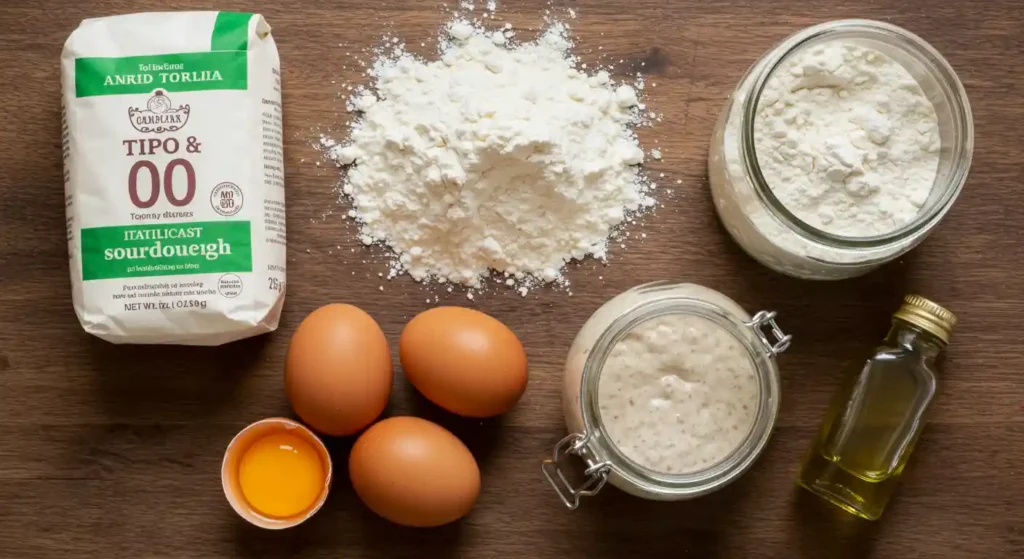
How to Make Sourdough Pasta Dough: Step-by-Step
Now that you’ve gathered your ingredients, it’s time to dive into the dough-making process. The beauty of sourdough pasta is that it can be prepared using various methods—whether you prefer the convenience of a food processor, the precision of a stand mixer, or the hands-on approach of kneading by hand. Below, I’ll guide you through each method, ensuring you have everything you need for success.
Making the Dough with a Food Processor
The food processor is the quickest way to make dough. I whisk the eggs and sourdough starter together, then add flour to the food processor. After pouring in the egg mixture, I pulse for 10-15 seconds until the dough forms. If it’s too crumbly, I pinch it together and process it until it becomes a rough ball. I then transfer it to a work surface, shape it, cover it with a bowl, and let it rest for 5-10 minutes to relax the dough.
Kneading the Dough by Hand or Using a Stand Mixer
For a hands-on experience, I knead the rested dough by pressing the heel of my hand into it and folding it over itself until smooth and elastic, about 1-2 minutes. If it’s too sticky, I add a bit of flour. Alternatively, with a stand mixer, I mix on low speed for 4-5 minutes until the dough forms. I then wrap it tightly in plastic wrap to prevent it from drying out while resting.
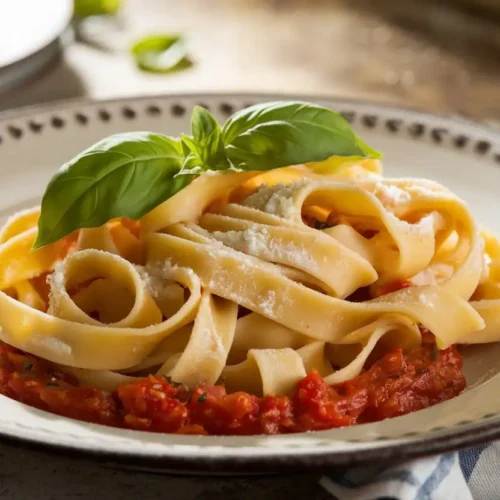
How to Make Sourdough Pasta
Ingredients
- 300 g Tipo 00 or all-purpose flour
- 165 g eggs about 3 large eggs
- 40 g active sourdough starter or sourdough discard
- Olive oil optional, for adjusting egg weight
- Semolina flour for dusting
Instructions
- Whisk eggs and sourdough starter together in a small bowl.
- Add flour to a food processor or stand mixer and pour in the egg mixture.
- Process until the dough begins to form, about 10-15 seconds. If needed, pinch the dough together and continue processing until it forms a rough ball.
- Knead the dough for 1-2 minutes by hand or in the stand mixer until smooth and elastic.
- Wrap the dough tightly in plastic wrap and let it rest for 5-10 minutes.
- Roll the dough into thin sheets and cut into desired pasta shape.
- Cook the pasta in boiling salted water for 2-7 minutes, depending on thickness.
Notes
- Use bubbly, active sourdough starter for the best flavor.
- If the egg weight is insufficient, add a bit of olive oil to balance.
- For a longer fermentation option, allow the dough to rest for up to 24 hours in the fridge.
Resting the Dough
Resting the dough is an essential step that ensures the gluten relaxes and the dough becomes more pliable. For a same-day dough, I leave it at room temperature for about an hour. For a richer, more flavorful pasta, I opt for the overnight fermentation method. After letting the dough rest at room temperature for an hour or two, I cover it tightly and refrigerate it for up to 24 hours. The longer fermentation allows the natural flavors of the sourdough starter to develop, yielding a more digestible and aromatic pasta. Just be sure to allow the dough to warm up for 30-60 minutes before rolling it out if it’s been chilled.
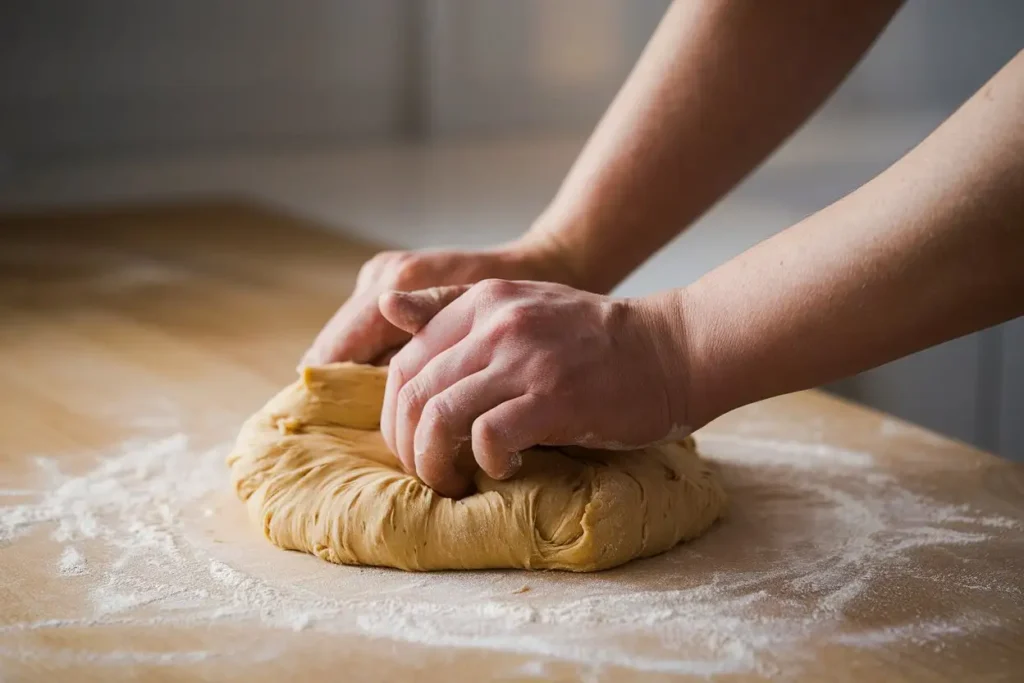
Rolling and Cutting Your Sourdough Pasta
Once your dough has rested, it’s time to roll it into sheets and cut it into your desired pasta shape. This is the most exciting part of making homemade pasta, and I always ensure that my workspace is well-prepared to accommodate the dough.
Rolling the Dough into Thin Sheets
I start by dividing the dough into four equal pieces. I flatten one piece into a rough disc shape, then dust it lightly with semolina flour to prevent sticking. Using a pasta machine or rolling pin, I pass the dough through the machine, starting at the widest setting. After the first pass, I progressively move the dough through narrower settings, ensuring the dough is evenly rolled out. If using a rolling pin, I stretch the dough by hand until it reaches the desired thinness. For most pasta types, I aim for the dough to be so thin that I can see my hand underneath it. This technique ensures a silky smooth texture that will hold up well when cooked.
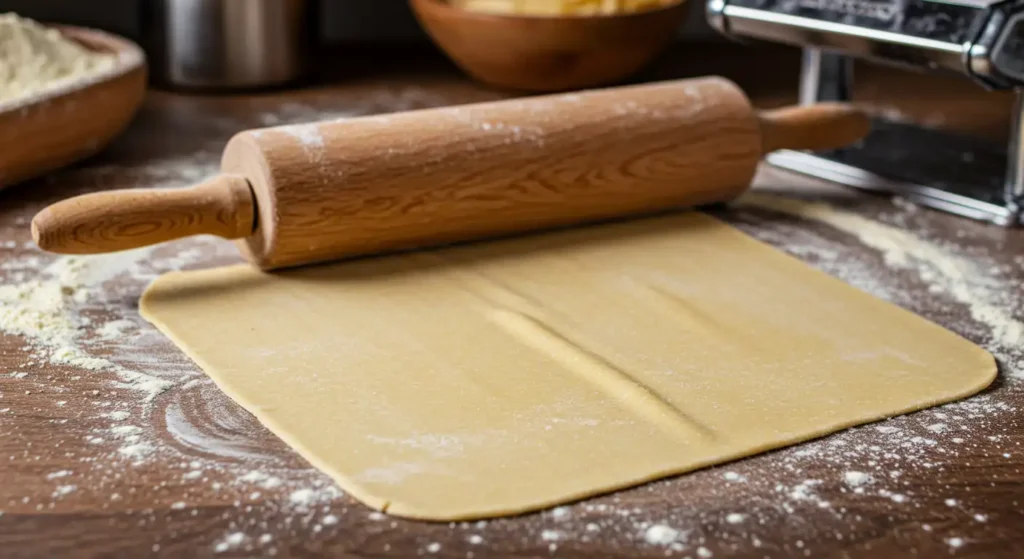
Cutting the Pasta Sheets into Strands
Once the dough is rolled out, I carefully fold it into half and begin cutting it into strips. I prefer to use the cutter attachment on my pasta machine to ensure uniform strands, but a sharp knife also works well. I typically cut the dough into spaghetti, fettuccine, or pappardelle, depending on the recipe I’m following. To prevent the freshly cut pasta from sticking together, I generously dust it with semolina flour and arrange the strands loosely on a tray.
Optional: Semi-Drying the Pasta
For a firmer texture and to prevent the pasta from becoming too soft and sticky, I like to semi-dry the pasta sheets before cutting them. I hang the sheets over the back of a chair or a rod for 5-15 minutes, allowing the dough to set slightly. This step is especially useful when making thicker pasta like pappardelle or tagliatelle, as it gives the pasta a more durable finish.
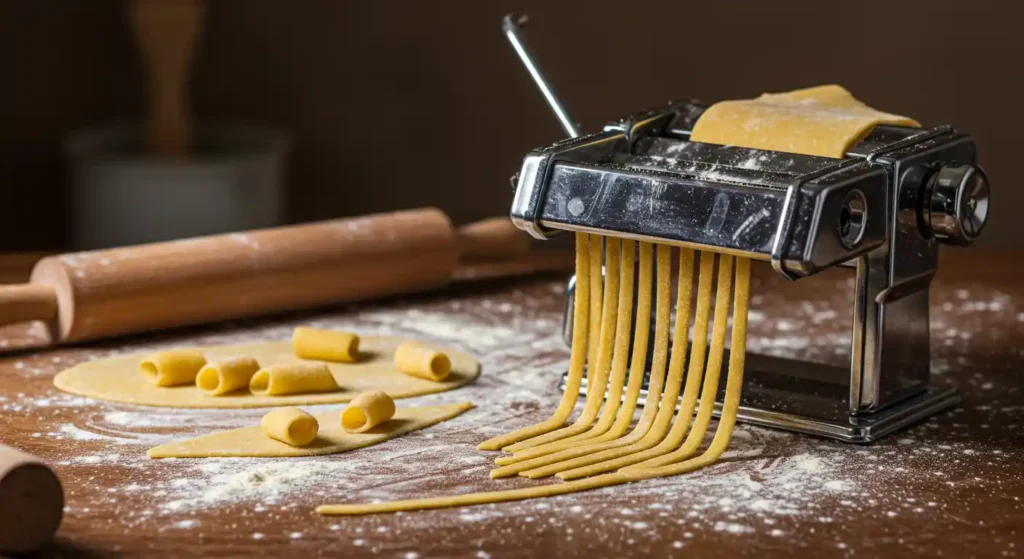
Cooking, Storing, and Freezing Sourdough Pasta
After all the hard work of making your sourdough pasta, the final step is cooking it. Depending on your plans, you may want to store or even freeze the pasta for later use.
Cooking Sourdough Pasta to Perfection
Cooking sourdough pasta is simple but requires attention to detail. I bring a large pot of salted water to a rolling boil, ensuring there’s plenty of room for the pasta to cook evenly. I cook the pasta for 2-7 minutes, depending on its thickness. For thinner pasta, like spaghetti, it cooks faster, while thicker noodles, such as pappardelle, take a bit longer. The key to perfect pasta is tasting it to ensure it’s al dente—soft with a slight bite.
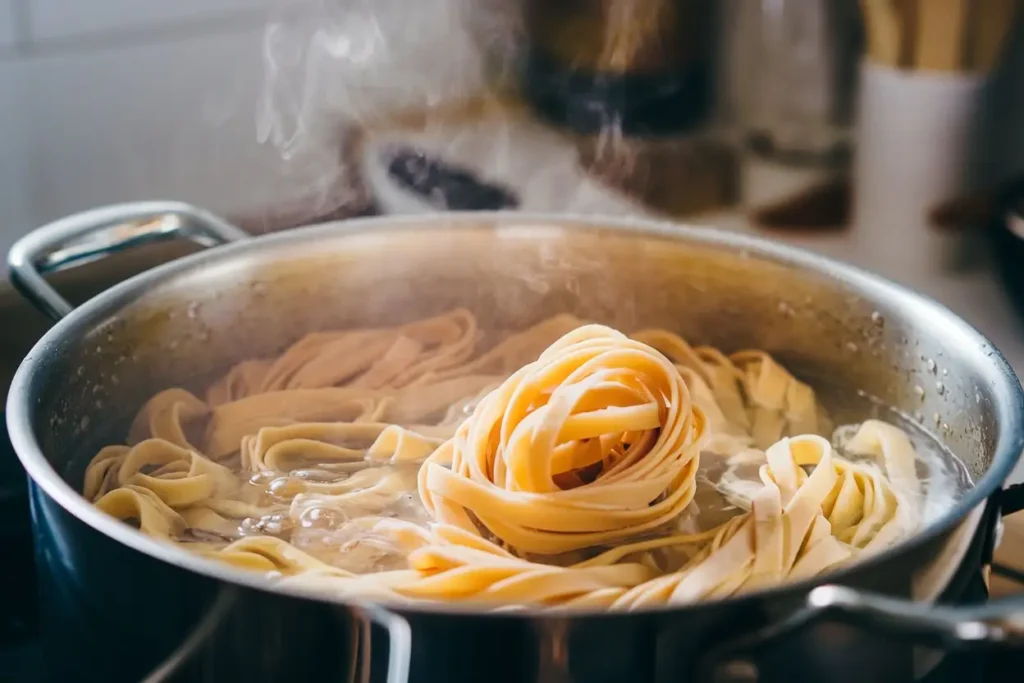
Storing Fresh Sourdough Pasta
If you’re not cooking the pasta immediately, storing it properly is crucial to preserve its freshness. I keep fresh pasta covered with plastic wrap or place it in an airtight container. It can sit at room temperature for up to 1-2 hours before cooking. For longer storage, I refrigerate it for up to 12 hours. The flavor of sourdough pasta will continue to develop as it sits, making it even more delicious the next day.
Freezing Sourdough Pasta for Later Use
To freeze the pasta, I let it air-dry on a tray for about 15-20 minutes. This ensures the strands won’t stick together when frozen. Once slightly dry, I transfer the pasta to zip-top bags, portioning it into meal-sized servings. The pasta can be frozen for up to a month. When it’s time to cook, I simply drop the frozen pasta directly into boiling water—there’s no need to thaw it first.

Conclusion: Why You Should Try Making Sourdough Pasta
Making sourdough pasta at home is a rewarding and gratifying experience. The process is surprisingly simple, and the results speak for themselves. By incorporating a sourdough starter into your pasta dough, you create a dish that’s not only delicious but also easier to digest. Whether you choose the 1-hour dough for a quick fix or opt for the 24-hour fermentation to deepen the flavor, you’re guaranteed a pasta experience that will elevate your meals. I encourage you to give this recipe a try and enjoy the authentic, artisanal touch that homemade sourdough pasta brings to your table.
Frequently Asked Questions (FAQs)
Is sourdough pasta better for you than regular pasta?
Sourdough pasta can be considered better for some people due to its fermentation process, which can make it easier to digest. The fermentation breaks down some of the gluten, improving digestibility and reducing potential bloating. Additionally, the tangy flavor and natural acids add a unique depth to the pasta.
Does sourdough pasta have less gluten?
Sourdough pasta may have less gluten than regular pasta because the fermentation process helps break down gluten proteins, making them easier to digest. However, it still contains gluten as it is made from wheat flour, so it is not gluten-free. People with severe gluten sensitivities should avoid sourdough pasta.
Why is sourdough gut healthy?
Sourdough is considered gut-healthy due to the fermentation process that promotes the growth of beneficial bacteria (probiotics). These bacteria help break down gluten and phytic acid, which can improve digestion and nutrient absorption. Sourdough’s natural acids also contribute to a balanced gut microbiome.
Is there such a thing as sourdough pasta?
Yes, sourdough pasta is a real culinary innovation that combines traditional pasta-making with the benefits of sourdough fermentation. It uses sourdough starter or discard in the dough, adding unique flavor and improving digestibility. Though not a traditional Italian recipe, it is gaining popularity among home cooks and food enthusiasts.

